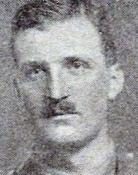
War Memorial
| Lieutenant Henry Basil Lindesay HINDE | |
|
3rd (Reserve) Battalion, Prince Albert's (Somerset Light Infantry) attached to Q Company, 1st Battalion, Oxfordshire and Buckinghamshire Light Infantry Date of birth: 29th April 1890 Date of death: 22nd November 1915 Killed in action aged 25 Commemorated on the Basra Memorial Panel 12 |

|
| Henry Basil Lindesay Hinde was born at 34, Egerton Gardens, Brompton in London on the 29th of April 1890 the only son of the Captain William Frederick Honeywood Hinde, 12th Lancers, and Edith Maude (nee Bagwell) Hinde of Drayton House, Uppingham in Rutland, later of Dilton Marsh in Wiltshire. He was educated at Hazelwood School until December 1902 where he was a member of the Choir. On leaving the school the school magazine wrote of him: - "....leaves for a Naval School. He has been a very useful chorister." He went on to a Naval School before matriculating for the University of London in September 1908 where he served for four years as a member of the University Officer Training Corps. On leaving university he became a mechanical engineer. Following the outbreak of war he enlisted as Private 1487 in the Motor Cycle Section of the 25th (County of London) Cyclist Battalion where he rose to the rank of Lance Corporal. He applied for a commission in the Royal Engineers or the infantry on the 31st of August 1914 but was turned down due to his eyesight. He lodged an appeal and went before the Appeal Board at the War Office who approved his appointment on the 11th of September 1914. He was commissioned as a Lieutenant in the 3rd (Reserve) Battalion, Prince Albert's (Somerset Light infantry), Special Reserve of Officers on the 24th of September 1914. He was attached to the 1st Battalion, Oxfordshire and Buckinghamshire Light Infantry on the 17th of June 1915 and was posted to Q Company. He was present at the Battle of Es Sinn in Mesopotamia on the 28th of September 1915. At 9am on the 22nd of November 1915 the British, under General Townshend, launched an attack against the Turks who numbered some 18,000, in what became the Battle of Ctesiphon. The Turks were entrenched on the left bank of the Tigris in two lines of trenches some 6,000 yards apart and greatly outnumbered the attacking British and Indian troops. The attacking force crossed 5,000 yards of open ground towards the Turkish positions under rifle, machine gun and artillery fire and despite suffering great casualties managed to force and capture the Turkish left end of the front line by 1pm. British casualties had been so great that only 250 men could be mustered to attempt an attack on the second line, but after hard fighting this attack had to be abandoned. The following account of his death comes from the regimental history:- “Lieutenant Mellor attached from the 2/5th Somersets, worked his way down the ditch which was only sufficiently deep, in a stooping position to provide cover from the bullets cracking like stock whips overhead. On his way he found Lieutenant Kearsley mortally wounded in the neck, and he therefore assumed command of R Company. Still without orders he continued to the left. On his way he met Lieutenant Hinde commanding Q Company, who was peering over the top of the ditch now and again to see what was happening. But any advance at that time would have been sheer madness, so hot and accurate was the fire; yet Lieutenant Hinde heeded not Lieutenant Mellor’s advice to take cover, and a second later a bullet went through his head.” His father received the following telegram dated the 26th of November 1915: - "Deeply regret to inform you that Lieut. H.B.L. Hinde Somerset L.I. was killed in action 22/24 Nov. The Secretary of State expresses his sympathy." He is commemorated on his parent’s grave at Bexhill Cemetery in Kent. |
|
Back